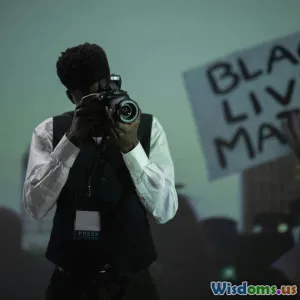
The Impact of Documentaries in Society
7 min read Explore how documentaries shape society, influence public opinion, and inspire action through storytelling and visual journalism. (0 Reviews)
The Impact of Documentaries in Society
Documentaries are far more than mere films; they are powerful vessels of truth, storytelling, and social engagement. Throughout history, these cinematic works have played a pivotal role in informing, inspiring, and activating audiences worldwide. In the age of photographic and filmmaking mastery, documentaries combine compelling visuals with rigorous journalistic storytelling to bridge the gap between complex realities and public consciousness.
Documentary Films: Beyond Entertainment
At first glance, many view documentaries simply as educational or entertainment content. However, their role in society extends profoundly into the realms of cultural reflection and social change. A documentary crafts a narrative distilled from reality, often uncovering hidden truths about individuals, communities, environmental crises, political struggles, or social issues.
Consider "The Thin Blue Line" (1988) by Errol Morris. This investigative film not only impacted the true-crime documentary genre but actually freed a man wrongly convicted of murder by challenging the justice system on screen. Its success underlines how documentaries can produce tangible societal effects beyond conventional entertainment.
Subheading 1: Visual Storytelling—Photography and Filmmaking at the Core
Photography and filmmaking are the foundations of documentary storytelling. The power lies in their ability to capture real moments that evoke empathy and urgency. High-quality cinematography combined with authentic storytelling crafts an immersive experience, forging a connection between viewers and subjects.
Take "13th" (2016), directed by Ava DuVernay, which uses archival footage, expert interviews, and poignant cinematography to dissect racial inequality in the American criminal justice system. The integration of compelling visual evidence with expert narrative constructs credibility and emotional resonance that statistics alone often fail to convey.
The role of close-up shots, honest interviews, and sequences from real environments activate an emotional response, humanizing complex issues and inspiring deeper contemplation.
Subheading 2: Catalysts for Social Awareness and Reform
History is peppered with documentaries influencing policy, societal attitudes, and cultural understanding. One seminal example is "An Inconvenient Truth" (2006), which catalyzed global conversations about climate change. Following its release, there was a documented increase in environmental activism, policy debates, and educational initiatives worldwide.
In another context, "Miss Representation" (2011) tackled gender stereotypes perpetuated by media. It spurred discussions about female representation in media industries, prompting some organizations to reassess internal policies and societal roles portrayed on screen.
Documentaries often challenge dominant narratives, giving marginalized voices a platform. By shining a spotlight on embedded injustices or overlooked issues, films can stir public accountability and ignite grassroots movements. The ripple effect of such media directly demonstrates their status as agents of social transformation.
Subheading 3: Ethical Considerations in Documentary Filmmaking
The power documentaries wield coincides with a responsibility towards honesty and respectfulness. Filmmakers engage with real people whose stories may expose vulnerabilities or contested truths. Ethical dilemmas arise around consent, representation, and narrative framing.
Renowned documentary filmmaker Werner Herzog advocates for a “poetic truth” over literal fact but emphasizes sincerity of purpose. Striking a balance between artistry and factual integrity is essential to maintain audience trust.
Moreover, photographers and filmmakers must be mindful of perpetuating stereotypes or sensationalism. For example, early photojournalistic works covering poverty sometimes drew criticism for extracting dignity rather than fostering empathy. Modern ethical standards now encourage collaborative processes with subjects and transparent storytelling.
Subheading 4: Documentary Distribution in the Digital Age
Streaming platforms like Netflix, Amazon Prime, and YouTube revolutionized the accessibility of documentaries. Unlike traditional limited-release cinema, these digital channels prospective audiences worldwide instantly.
This democratization facilitates global dialogue on issues through viral sharing or interactive discussions on social media. Documentaries such as "Blackfish" (2013) reached millions, influencing public perception and policy on marine animal treatment due to the film’s wide digital reach.
Enhanced technology in filmmaking also lowers barriers for emerging creators, enriching the diversity of perspectives documented and available.
Conclusion: The Enduring Power of Documentaries
Documentaries, forged through photography and filmmaking, illuminate realities often ignored or hidden. These evocative narratives educate the public, influence societal values, and catalyze reforms—making them formidable pillars of social discourse.
As viewers, understanding and supporting documentaries means embracing a medium that not only informs but inspires transformation. Whether through exposing injustice, advocating environmental stewardship, or celebrating cultural identities, documentaries mold collective consciousness with visual clarity and emotional potency.
The next time you watch a documentary, recognize it as more than a film—it’s a call to awareness and, ultimately, action.
Notable Documentaries and Their Societal Impact
- The Thin Blue Line (1988): Freed a wrongly convicted man, showcasing documentary power in criminal justice.
- An Inconvenient Truth (2006): Elevated public engagement with climate change worldwide.
- 13th (2016): Highlighted racial disparities in incarceration, fueling policy considerations.
- Blackfish (2013): Led to regulatory scrutiny and public debate about captivity of orcas.
Quotes from Influential Filmmakers
“The documentary film has the power to make people see their world differently, to change the way they view what’s normal.” – Ava DuVernay
“Every documentary is a small step towards making reality visible.” – Errol Morris
Through its intricate marriage of photography and filmmaking, documentary cinema continues to be one of society’s most potent tools for empathy, education, and justice.
Rate the Post
User Reviews
Popular Posts





















